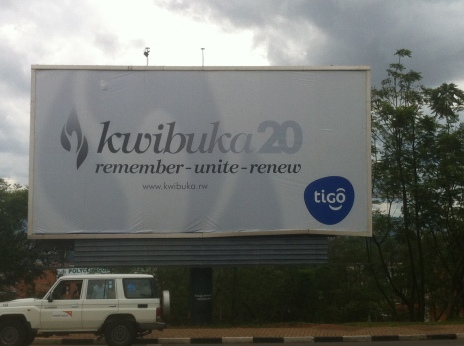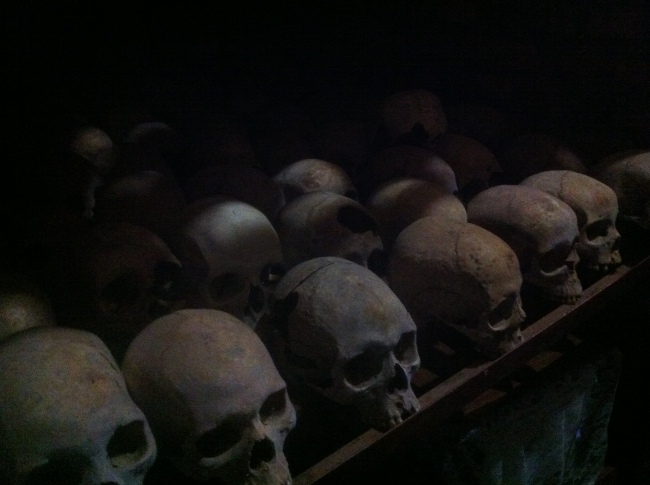Yes, it’s now been nearly two weeks since we celebrated Good Friday and then Easter, but it’s been on my mind since then. For those who don’t keep up these sorts of things, Holy Week basically celebrates the final lead up to Easter and the end of Lent. It begins with Jesus’ entry into Jerusalem (Palm Sunday), and includes the last supper, the last supper, the betrayal of Jesus, and obviously the crucifixion, death and burial of Jesus.
During Holy Week, I found myself in Kigali, Rwanda taking a vacation from life and work in Kasese. I happened to be surrounded by people who “don’t keep up” with these traditions because many of the wonderful people I know in Rwanda are Muslim. I also happened to be surrounded by a country that was in the middle of remembering the 20th anniversary of the April-June 1994 genocide. In Rwanda, the whole country participates in at least a week long remembrance in which there are walks, events and speeches; shops close often and people take time off work to either attend official events or be with family. Participation isn’t exactly a choice, but nevertheless it is a time of national reflection.
For as long as I can remember, Maundy Thursday meant the beginning of the “holy” part of Holy Week. At seven in the evening we would show up at church, prepared for a very solemn service. This is the one that includes “washing of the feet.” At Transfiguration, my church growing up, this was one of the most powerful parts of any service in the year. Approaching the altar, bare feet on the cold lacquered bricks, the sense of deep sadness and confusion was overwhelming- mirroring for me the disciples’ emotions in the story of the last supper. Having your feet washed by someone else (not to mention by someone your respect, like your priest) is a humbling experience and you can’t help be moved by the charge given: “love one another as I have loved you.”
On this particular Thursday, I took a trip about 45 minutes from downtown Kigali to a place called Nyamata. Nyamata holds one of many many genocide memorial sites in the country, and here it is a church. When the mass killings really got underway, many people fled to churches, thinking they might be a kind of safe haven from their pursuers. Tragically, this only facilitated killing a large number of people at one time. The Nyamata church is a stark reminder of this.
Inside, every single pew holds piles and piles of dusty and tattered clothes and on the altar sit trinkets- rosaries, ID cards, rings, eyeglasses. The church and its content stand much as they did in 1994, a reminder of the thousands killed there. A far cry from the museum at the main memorial in town, full of information and videos, Nyamata slaps you in the face. The clothing of victims are there to touch, not behind glass cases.
Outside, however, I ventured down into the mass graves. Unlike going anywhere in the US, there are no “do not touch” signs and very few safeguards on “exhibits.” The first crypt my companion and I entered held dozens of coffins, many unmarked. The second held shelves and shelves of human skulls and bones. A quick calculation put the number of skulls around four thousand.
After the Thursday service at home, the altar and the church are stripped of all ornamentation and life until the great Vigil service on Saturday night- when we celebrate Jesus’ resurrection. So for those three days, the church is eerily empty and purposefully more contemplative.
Now the Rwandan Genocide of 1994 is not a clear-cut event, as much as the government tends to portray it as such, with one group as victims and the other as killers. The lack of international attention during those hundred days remains largely unresolved. From what I heard, the reconciliation efforts don’t take nearly as much care as flashy New York Times op-eds want us to believe. Even so, what happened then was very obviously a terrible thing and left many deep wounds.
Standing amidst piles of clothes and in between rows of neatly packed skulls certainly distills the events of 1994 past any sort of political and moral issues that remain. This Maundy Thursday was one of only a couple times that I was even inside a church during Lent. I think it was fitting, though. Just as we empty the church of all signs of life- including the holy sacrament- so too was this church very empty of life. It was very full of the opposite. I couldn’t help but imagine getting my feet washed in the spot where surely at least thousands perished, being told to obey this one commandment…to love others.
In my opinion, we often ascribe much more meaning to the church building, and the Church, than is safe. Twenty years ago, it didn’t make a shred of difference if you were huddled in a “holy place” or out on the open road. It’s not uncommon to talk about taking God outside of the church walls, of course, but even the Church is our own construction. Yes, we the people are the Church, but religion is not faith. Faith is faith and religion tries to make sense of it. At least that’s my general understanding. For many the Church can be a dangerous place- just as many churches were in 1994 in Rwanda. How can that be combated? How can we remember and honor the fact that even if all the structural parts of religion fall away we can still be left with real belief?
Holy Week was always the climax of the liturgical year for me precisely because we try so hard to bring these events that we talk about close to home. We make them very tangible. My Holy Week was highlighted by a much closer smell, touch, and feeling of death. I have realized that a lot of my questions about faith recently stem from a desire to make sense out of everything through our religion. When we rely only on our Church’s traditions we can seriously harm people; when we forget about belief we can create a dangerous place. What does make sense is the commandment we give on that Thursday- to love. I don’t know if I’ve felt a better reminder of the necessity for this love than two weeks ago in church.



Every post, Alex, gives me another perspective to ponder. You make me think- my absolute favorite pasttime! thank you, thank you, for your passion and insight. It is such a joy to be connected to you, brother!
BTW, just finished The Teeth May Smile but the Heart Does Not Forget: Murder and Memory in Uganda by Andrew Rice. Wonderful historical background to current day Uganda. If you haven’t read it, I recommend it! Would love your perspective having lived there for a year.